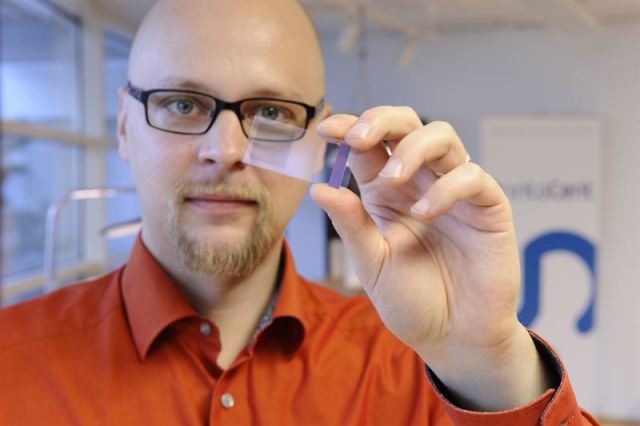Nov 11 2015
VTT spin-off Dispelix brings 60-inch virtual display to smartglasses
Spin-off company Dispelix Oy will commercialise a new display - developed by VTT Technical Research Centre of Finland - which brings visual information directly into the user's field of vision, as a high-definition image on an eyeglass lens. This will enable smartglasses to replace even smartphones or tablets, while still allowing users to see the world around them. Also integrable with current smartglasses, this product should be available to consumers within a year.
 "This display, which can be almost invisibly integrated into lenses, is already close to the markets and ready for high-volume applications," Antti Sunnari points out.
"This display, which can be almost invisibly integrated into lenses, is already close to the markets and ready for high-volume applications," Antti Sunnari points out.
"As electronics and optics evolve, displays will even be seamlessly integrated into ordinary glasses," predicts Antti Sunnari, Managing Director of Dispelix Oy, which is commercialising the technology.
The forthcoming displays will have unlimited applications for consumer and professional use. The first applications will be found in the worlds of exercise, work and motor sports. Thanks to the new display, a sportsperson will no longer need to check his or her pulse-rate from a watch - pulse-rate, navigation and activity data will be directly displayed on sport glasses.
The innovative display is also ideal for enterprise applications. Smartglasses will boost work efficiency by allowing workers to use both hands in difficult conditions, or to learn more about the task as the work progresses. New applications for Dispelix's display technology and smartglasses will appear in areas such as healthcare, the manufacturing and process industry and logistics.
The technology is based on lightguide optics, which enables the manufacture of displays on either glass or plastic in the form of light and thin elements with a thickness of just one millimetre. In addition to thinness, the benefits of the technology include a large, high-quality virtual image and excellent transparency. The display element can also be freely shaped.
"Compared to existing solutions, which are bulky or difficult to manufacture, the Dispelix solution has advantages such as the display's thinness, lightness, aesthetic appearance and volume production compatibility," says Sunnari.
The display's user-friendliness is boosted by the fact that the virtual image forms within the user's field of vision, which prevents eye strain. Dispelix's display solution can be customised to meet different customer needs - depending on the application, either simple, monochrome information or a multi-coloured video image can be displayed within the user's field of vision.
"The size of the virtual image is equivalent to a 60-inch TV viewed from a distance of three metres," Sunnari explains.
Dispelix is currently fund-raising and building a partner network in order to accelerate commercialisation. The displays are ready for volume production and the company aims to make the first customer deliveries in 2016.
Augmented reality and virtual reality markets are forecast to hit $150B revenue by 2020, from which optics share is $1.5B.